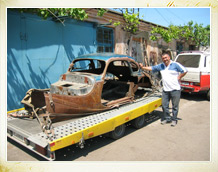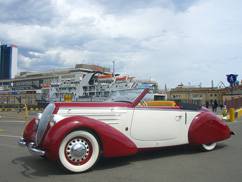Theis Steyr 220 Glaser Sport is not a usual vehicle of Austrian production. The one was produced on special demand on Glaser in Dresden (Germany). Possibly, it's only one vehicle in the world in that kind of body.
Original and esthetically beautiful were coupes with streamlines, although in general they were four-door limousines with radial tires, frameworks and breakers, which were manufactured out of Metal cord and in a way, it is wooden-metallic construction with addition of glass.
Special performance of order were produced and supplied with Erdman & Rossi and also with Austrian coupe manufactures for auto market. Automobiles with four cylinders are durable and reliable in exploitation. This automobile could not be called sport one, but with this car You are fearless, when coping quietly with steep ascent of 32 %, which expects every fast Austrian from his car.
Much more capacity is allowed with six-cylinder auto, although, first of all, only the model 220. Deserved confidence and win high status among customers. In Austria given model rightfully belongs to last pre-war years, in which automobiles were still produced and to automobiles of high standards. Model 125, which foregoes model 125 (also known as 125 Super) war produced exceptionally for German market. During the war, cabriolets with six cylinders from Stair were destined for many headquarters officers and for other commanders. They were marked with state emblems and symbols.








































































